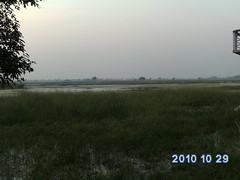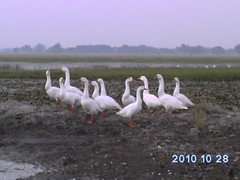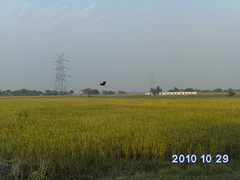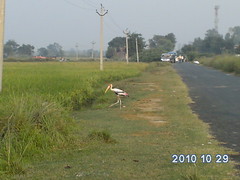


![Growers of Water Caltrop [Trapa natans], Singhara, in wetland area, Sarsai Nawar](http://farm2.static.flickr.com/1260/5129058668_a900f9cde5_m.jpg)


The Ramsar Convention (Article 1.1) defined wetlands as: “areas of marsh, fen, peat land, or water, whether natural or artificial, permanent or temporary, with water that is static or flowing, fresh, brackish or salt, including areas of marine water the depth of which at low tide doesn’t exceed six meters”. In addition, the convention (Article 2.1) provides that wetlands: “may incorporate riparian and coastal zones adjacent to the wetlands, and islands or bodies of marine water deeper than six meters at low tide lying within the wetlands. Wetlands are among the most productive ecosystems in the world, comparable to rain forests and coral reefs. In wetland ecosystem water is the primary factor controlling both the plant and animal life; they are found on every continent except Antarctica and from the tundra to the tropics . Wetlands fall into four general categories—marshes, swamps, bogs, and fens. Marshes are wetlands dominated by soft-stemmed vegetation, while swamps have mostly woody plants. Bogs are freshwater wetlands, often formed in old glacial lakes, characterized by spongy peat deposits, evergreen trees and shrubs, and a floor covered by a thick carpet of sphagnum moss. Fens are fresh water peat-forming wetlands covered mostly by grasses, sedges, reeds, and wild flowers. Wetlands favours particular type of trees, shrubby species and associated herbs and grasses with algae. Typical characteristic species of wetland ecosystem include hydrophytes such as Cyperus, Azolla, Nymphaea, Typha, Potamogoton, Wolffia, Phragmites, Eichhornia etc., and tree species include species of Ficus, Tamarindus indica, Mimusops, Syzygium, Terminalia, Acacia, Mangifera. An immense variety of species of insects, amphibians, reptiles, birds, fish, and mammals forms fauna of wetlands. Some birds, for example, Plover, Goose, Crane, Flamingo like feed and breeds in wetlands. Detritus Food Chain is the important part of wetland ecosystems. Due to typical functions like- wildlife habitat and food chain support, groundwater recharge, water purification, nutrient retention and flood control- wetlands are considered as "biological supermarkets", "nurseries of life" and "the kidneys of the landscape" (Barbier et al. 1997; Mitsch and Gosselink 1993). India is very rich in wetland habitats; Wetlands in India (excluding rivers), account for 18.4% of the country’s geographic area, of which 70% is under paddy cultivation; there are 21 "Ramsar sites in India".
Under the National Wetlands Conservation Programme (NWCP) programme, 115 wetlands (Annexure I) have been identified till now by the Ministry of Environment(India) and SARSAI NAWAR (area 161.27 ha.) is part of this and is listed at serial number 101. Sarsai Nawar is a vast and beautiful wetland (it is an open form of fen) situated in Takha block of District Etawah. In India, wetlands are disappearing at a rate of 2% to 3% every year and Sarsai Nawar wetland is also facing threats for existence; major threats are- anthropogenic activities, agriculture activities, deforestation, pesticides pollution, rural sewage pollution, introduced species threats due to Eichhornia etc. Trapa and Eichhornia have adverse impact on aquatic ecosystems. Conservation of this wetland is must for the survival of Sarus Cranes (Grus antigone) and many migratory birds as this wetland is the important part of their life and is must for their survival. Migrating birds use wetlands to rest and feed during their cross-continental journeys and as nesting sites when they are at home. As a result, wetland loss has a serious impact on these species.
Also listen about wetlands by just click here.
Sir apse sahmat hun jab tak log aage nahee ayenge sarsainawar jheel ka yahee hal rahega.Ye jheel etawah kee pahchan hai........-Lalit
ReplyDelete